Portable Skin Analyzers with Simultaneous Measurements of Transepidermal Water Loss, Skin Conductance and Skin Hardness
Abstract
1. Introduction
2. Experimental
2.1. Working Principle
2.2. Design and Implementation
2.3. Calibration of the Measurements
3. Results and Discussion
4. Conclusions
Supplementary Materials
Author Contributions
Funding
Conflicts of Interest
References
- Firooz, A.; Sadr, B.; Babakoohi, S.; Sarraf-Yazdy, M.; Fanian, F.; Kazerouni-Timsar, A.; Nassiri-Kashani, M.; Naghizadeh, M.M.; Dowlati, Y. Variation of Biophysical Parameters of the Skin with Age, Gender, and Body Region. Sci. World J. 2012, 2012, 1–5. [Google Scholar] [CrossRef]
- Segger, D.; Matthies, A.; Saldeen, T. Supplementation with Eskimo® Skin Care improves skin elasticity in women. A pilot study. J. Dermatol. Treat. 2008, 19, 279–283. [Google Scholar] [CrossRef]
- Machado, M.; Salgado, T.M.; Hadgraft, J.; Lane, M.E. The relationship between transepidermal water loss and skin permeability. Int. J. Pharm. 2010, 384, 73–77. [Google Scholar] [CrossRef]
- Nuutinen, J.; Alanen, E.; Autio, P.; Lahtinen, M.R.; Harvima, I.; Lahtinen, T. A closed unventilated chamber for the measurement of transepidermal water loss. Skin Res. Technol. 2003, 9, 85–89. [Google Scholar] [CrossRef]
- Berg, E.P.; Pascut, F.C.; Ciortea, L.I.; Driscoll, D.O.; Xiao, P.; Imhof, R.E. AquaFlux—A New Instrument for Water Vapour Flux Density Measurement. In Proceedings of the 4th international Symposium on Humidity & Moisture, Taipei, Taiwan, 16–19 September 2002. [Google Scholar]
- Oliver, G.J.A.; Dugard, P.H. A Comparison of Techniques for the Measurement of Transepidermal Water Loss. Arch. Dermatol. Res. 1982, 274, 57–64. [Google Scholar]
- Lodén, M. Effect of moisturizers on epidermal barrier function. Clin. Dermatol. 2012, 30, 286–296. [Google Scholar] [CrossRef]
- Ferguson, J.S.; Yeshanehe, W.; Matts, P.; Davey, G.; Mortimer, P.; Fuller, C. Assessment of skin barrier function in podoconiosis: Measurement of stratum corneum hydration and transepidermal water loss. Br. J. Dermatol. 2013, 168, 550–554. [Google Scholar] [CrossRef]
- Fluhr, J.W.; Gloor, M.; Lazzerini, S.; Kleesz, P.; Grieshaber, R.; Berardesca, E. Comparative study of five instruments measuring stratum corneum hydration (Corneometer CM 820 and CM 825, Skicon 200, Nova DPM 9003, DermaLab). Part I. In vitro. Skin Res. Technol. 1999, 5, 161–170. [Google Scholar] [CrossRef]
- Baroni, A.; Buommino, E.; De Gregorio, V.; Ruocco, E.; Ruocco, V.; Wolf, R. Structure and function of the epidermis related to barrier properties. Clin. Dermatol. 2012, 30, 257–262. [Google Scholar] [CrossRef]
- Sim, J.K.; Cho, Y.-H. Portable sweat rate sensors integrated with air ventilation actuators. Sens. Actuators B Chem. 2016, 234, 176–183. [Google Scholar] [CrossRef]
- Sim, J.K.; Yoon, S.; Cho, Y.-H. Wearable Sweat Rate Sensors for Human Thermal Comfort Monitoring. Sci. Rep. 2018, 8, 1181. [Google Scholar] [CrossRef]
- Kreibig, S.D.; Wilhelm, F.H.; Roth, W.T.; Gross, J.J. Cardiovascular, electrodermal, and respiratory response patterns to fear- and sadness-inducing films. Psychophysiology 2007, 44, 787–806. [Google Scholar] [CrossRef]
- Yoon, S.; Sim, J.K.; Cho, Y.-H. A Flexible and Wearable Human Stress Monitoring Patch. Sci. Rep. 2016, 6, 23468. [Google Scholar] [CrossRef]
- Romanelli, M.; Falanga, V. Use of a durometer to measure the degree of skin induration in lipodermatosclerosis. J. Am. Acad. Dermatol. 1995, 32, 188–191. [Google Scholar] [CrossRef]
- Falanga, V.; Bucalo, B. Use of a durometer to assess skin hardness. J. Am. Acad. Dermatol. 1993, 29, 47–51. [Google Scholar] [CrossRef]
- Niyaz, A.; Matsumura, H.; Watanabe, K.; Hamamoto, T.; Matsusawa, T. Quantification of the physical properties of keloid and hypertrophic scars using the Vesmeter novel sensing device. Int. Wound J. 2012, 9, 643–649. [Google Scholar] [CrossRef]
- Pedersen, L.; Jemec, G.B.E. Mechanical properties and barrier function of healthy human skin. Acta Derm. Venereol. 2006, 86, 308–311. [Google Scholar] [CrossRef]
- Tobin, D.J. Introduction to skin aging. J. Tissue Viability 2017, 26, 37–46. [Google Scholar] [CrossRef]
- Wickett, R.R.; Visscher, M.O. Structure and function of the epidermal barrier. Am. J. Infect. Control 2006, 34, 98–110. [Google Scholar] [CrossRef]
- Yoon, S.; Sim, J.K.; Park, N.; Cho, Y.H. Evaluation of Skin Hardness as a Physiological Sign of Human Thermal Status. Sci. Rep. 2018, 8, 12027. [Google Scholar] [CrossRef]
- Kim, J.; Seo, D.G.; Cho, Y.H. A flexible skin piloerection monitoring sensor. Appl. Phys. Lett. 2014, 104, 253502. [Google Scholar] [CrossRef]
- Xu, K.; Lu, Y.; Takei, K. Multifunctional Skin-Inspired Flexible Sensor Systems for Wearable Electronics. Adv. Mater. Technol. 2019, 4, 1–25. [Google Scholar] [CrossRef]
- Lee, Y.; Kim, J.; Joo, H.; Raj, M.S.; Ghaffari, R.; Kim, D.-H. Wearable Sensing Systems with Mechanically Soft Assemblies of Nanoscale Materials. Adv. Mater. Technol. 2017, 2, 1700053. [Google Scholar] [CrossRef]
- Xu, K.; Lu, Y.; Honda, S.; Arie, T.; Akita, S.; Takei, K. Highly stable kirigami-structured stretchable strain sensors for perdurable wearable electronics. J. Mater. Chem. C 2019, 7, 9609–9617. [Google Scholar] [CrossRef]
- Gankande, T.U.; Duke, J.M.; Danielsen, P.L.; DeJong, H.M.; Wood, F.M.; Wallace, H.J. Reliability of scar assessments performed with an integrated skin testing device—The DermaLab Combo®. Burns 2014, 40, 1521–1529. [Google Scholar] [CrossRef]
- Ye, L.; Wang, Z.; Li, Z.; Lv, C.; Man, M.Q. Validation of GPSkin Barrier® for assessing epidermal permeability barrier function and stratum corneum hydration in humans. Skin Res. Technol. 2019, 25, 25–29. [Google Scholar] [CrossRef]
- Sim, J.K.; Ahn, B.; Doh, I. Truncated Hollow Cone Probe for Assessing Transepidermal Water Loss and Skin Hardness. ACS Sens. 2018, 3, 2246–2253. [Google Scholar] [CrossRef]
- Villarejo, M.V.; Zapirain, B.G.; Zorrilla, A.M. A Stress Sensor Based on Galvanic Skin Response (GSR) Controlled by ZigBee. Sensors 2012, 12, 6075–6101. [Google Scholar] [CrossRef]
- Briscoe, B.J.; Sebastian, K.S.; Adams, M.J. The effect of indenter geometry on the elastic response to indentation. J. Phys. D Appl. Phys. 1994, 27, 1156–1162. [Google Scholar] [CrossRef]
- Imhof, R.E.; De Jesus, M.E.P.; Xiao, P.; Ciortea, L.I.; Berg, E.P. Closed-chamber transepidermal water loss measurement: Microclimate, calibration and performance. Int. J. Cosmet. Sci. 2009, 31, 97–118. [Google Scholar] [CrossRef]
- Jachowicz, R.; Weremczuk, J.; Tarapata, G. Transepidermal water loss sensor based on fast dew point hygrometer. Sens. Actuators A Phys. 2005, 123, 7–11. [Google Scholar] [CrossRef]
- Tarapata, G.; Weremczuk, J.; Jachowicz, R. Evaluation of water barrier function of human skin using super fast dew point hygrometer. In Proceedings of the International Workshop on Medical Measurements and Applications—MeMeA 2007, Warsaw, Poland, 4–5 May 2007; pp. 1–5. [Google Scholar]
- Kim, D.; Tcho, I.W.; Jin, I.K.; Park, S.J.; Jeon, S.B.; Kim, W.G.; Cho, H.S.; Lee, H.S.; Jeoung, S.C.; Choi, Y.K. Direct-laser-patterned friction layer for the output enhancement of a triboelectric nanogenerator. Nano Energy 2017, 35, 379–386. [Google Scholar] [CrossRef]
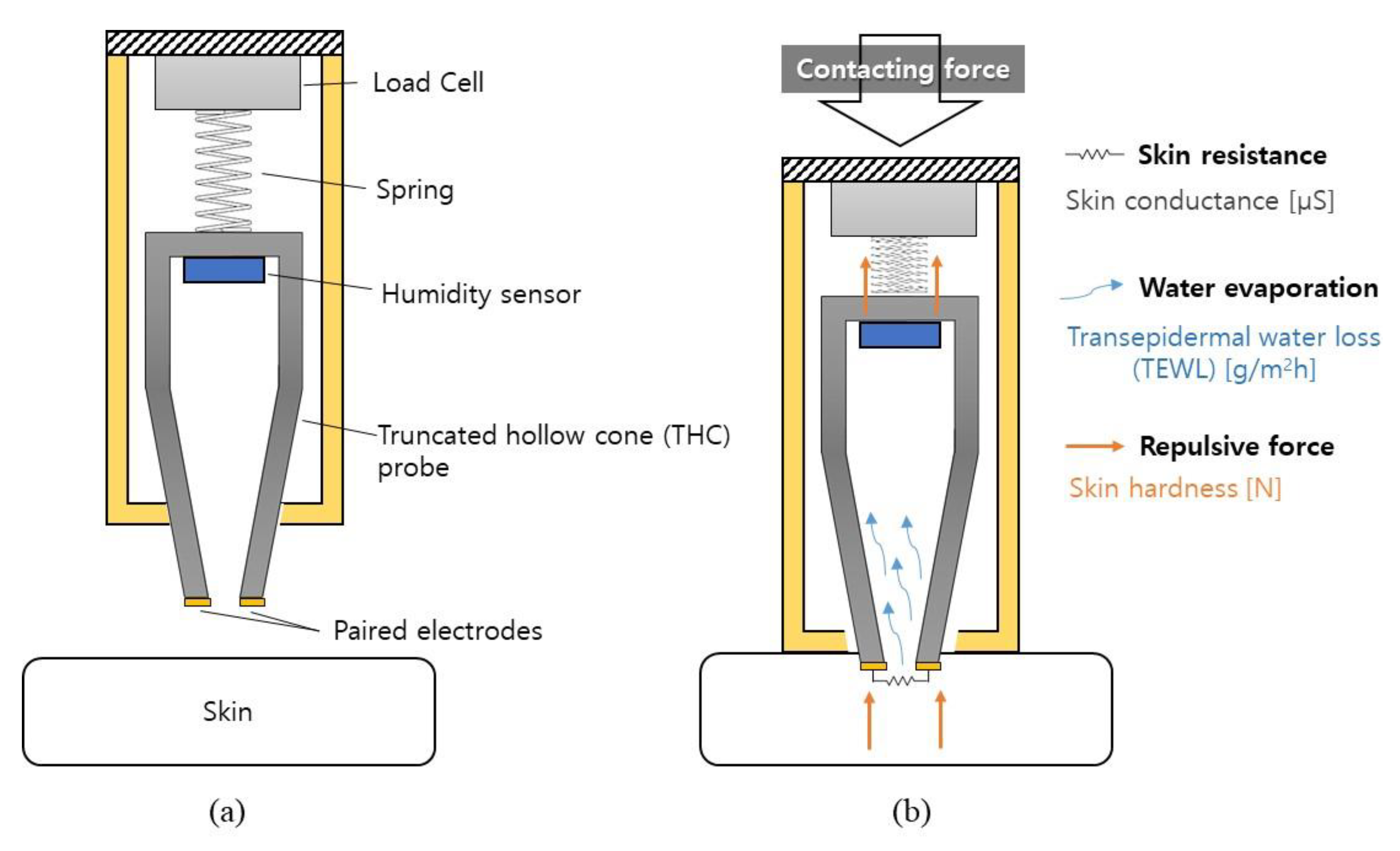
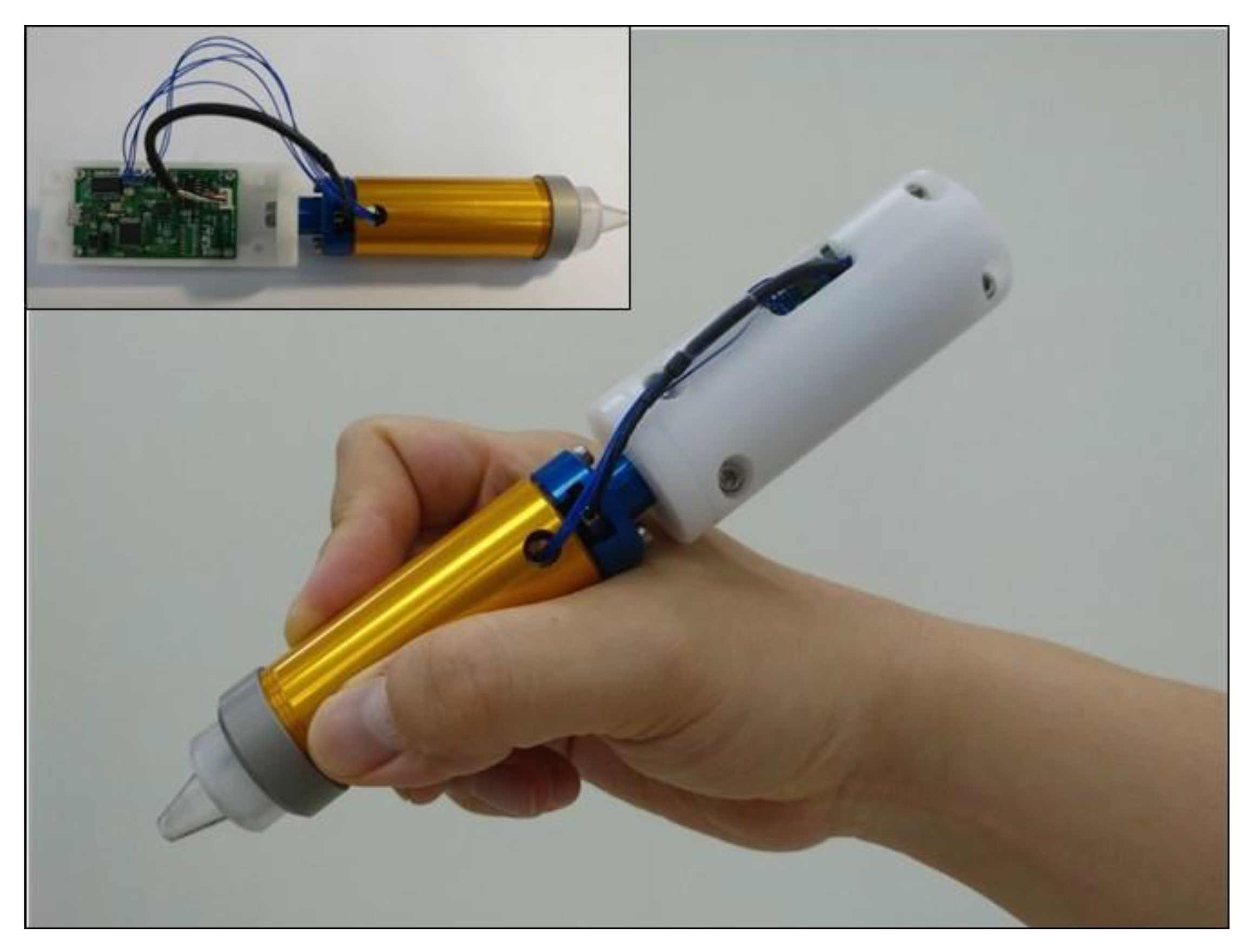
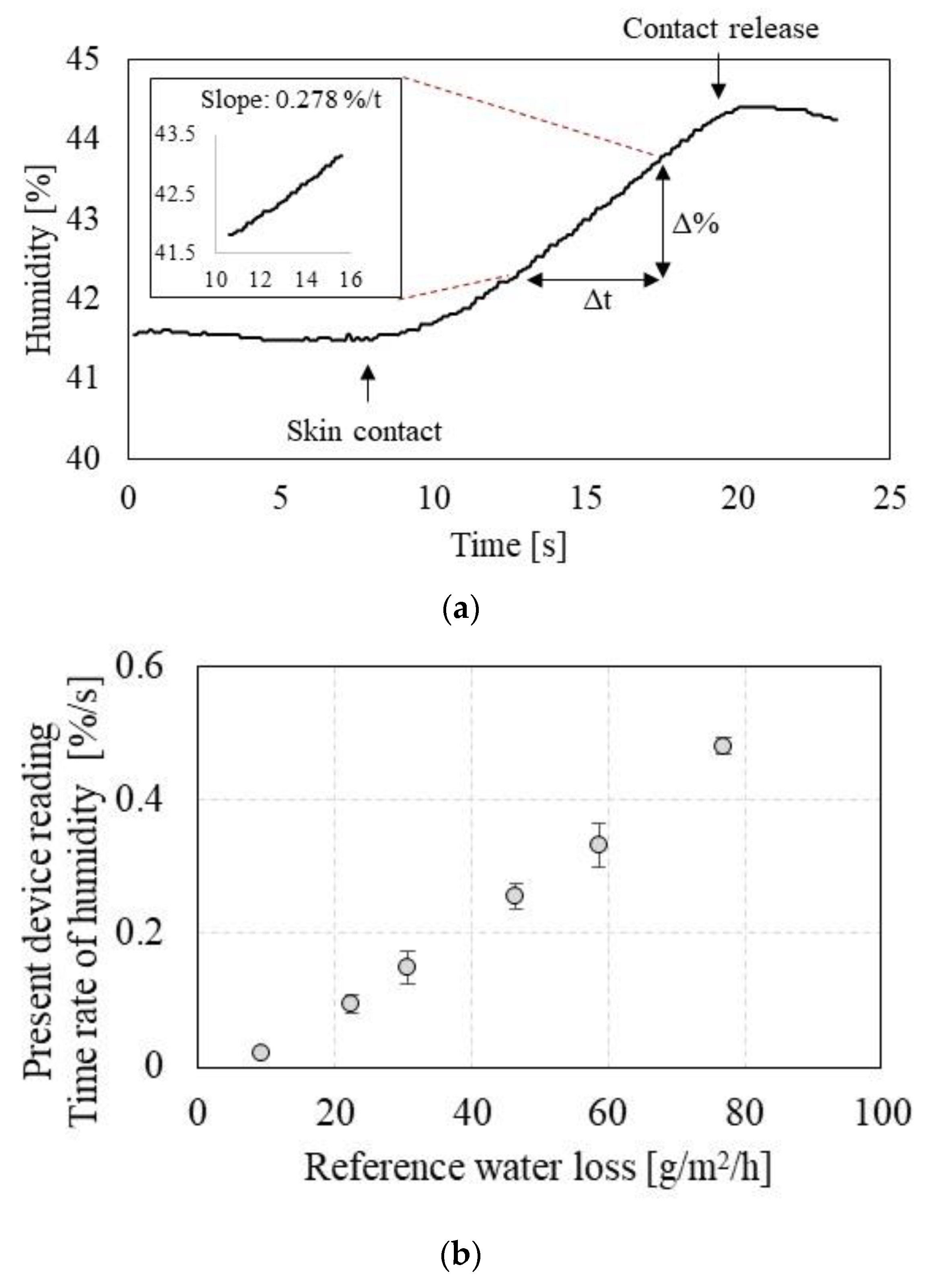
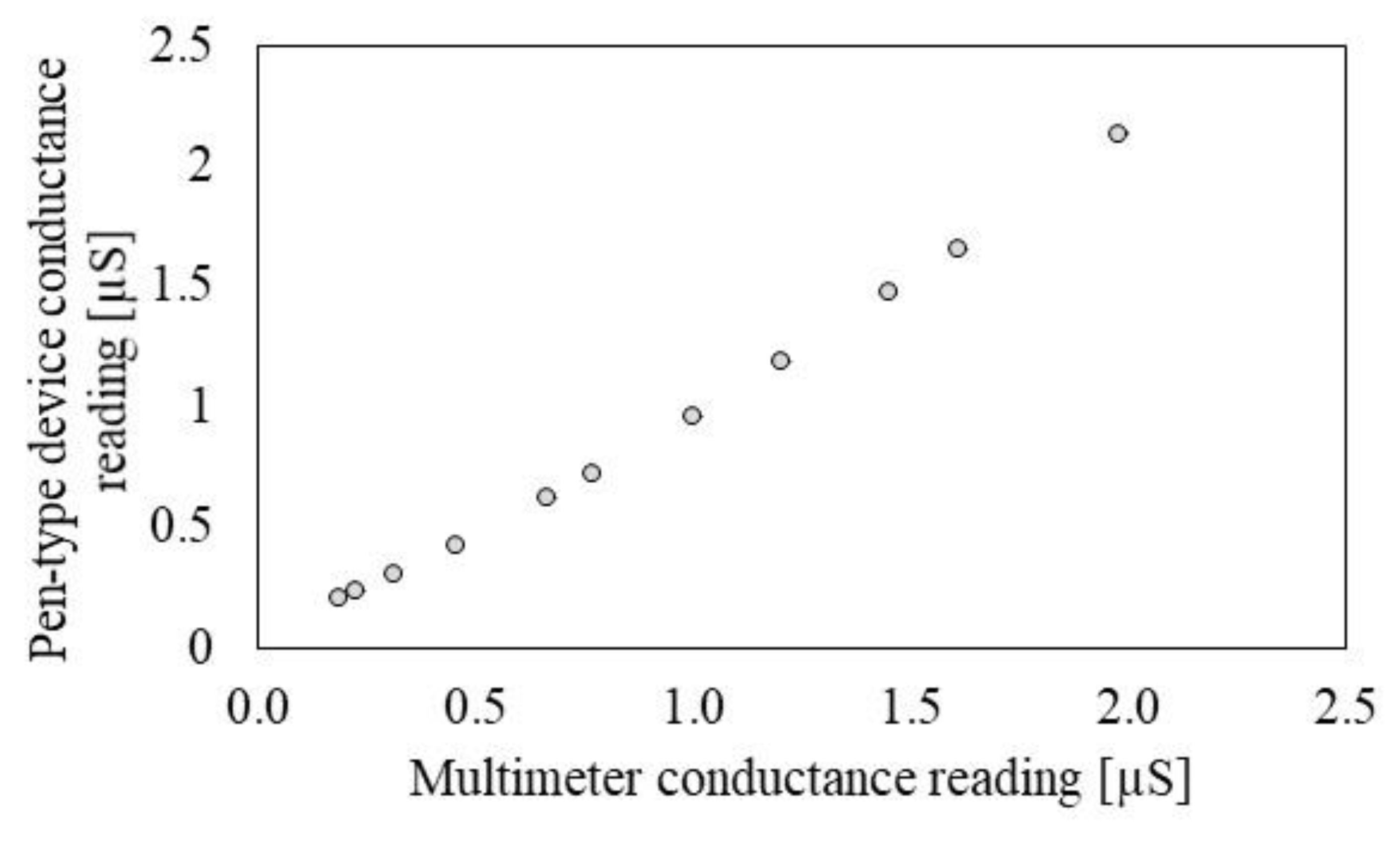

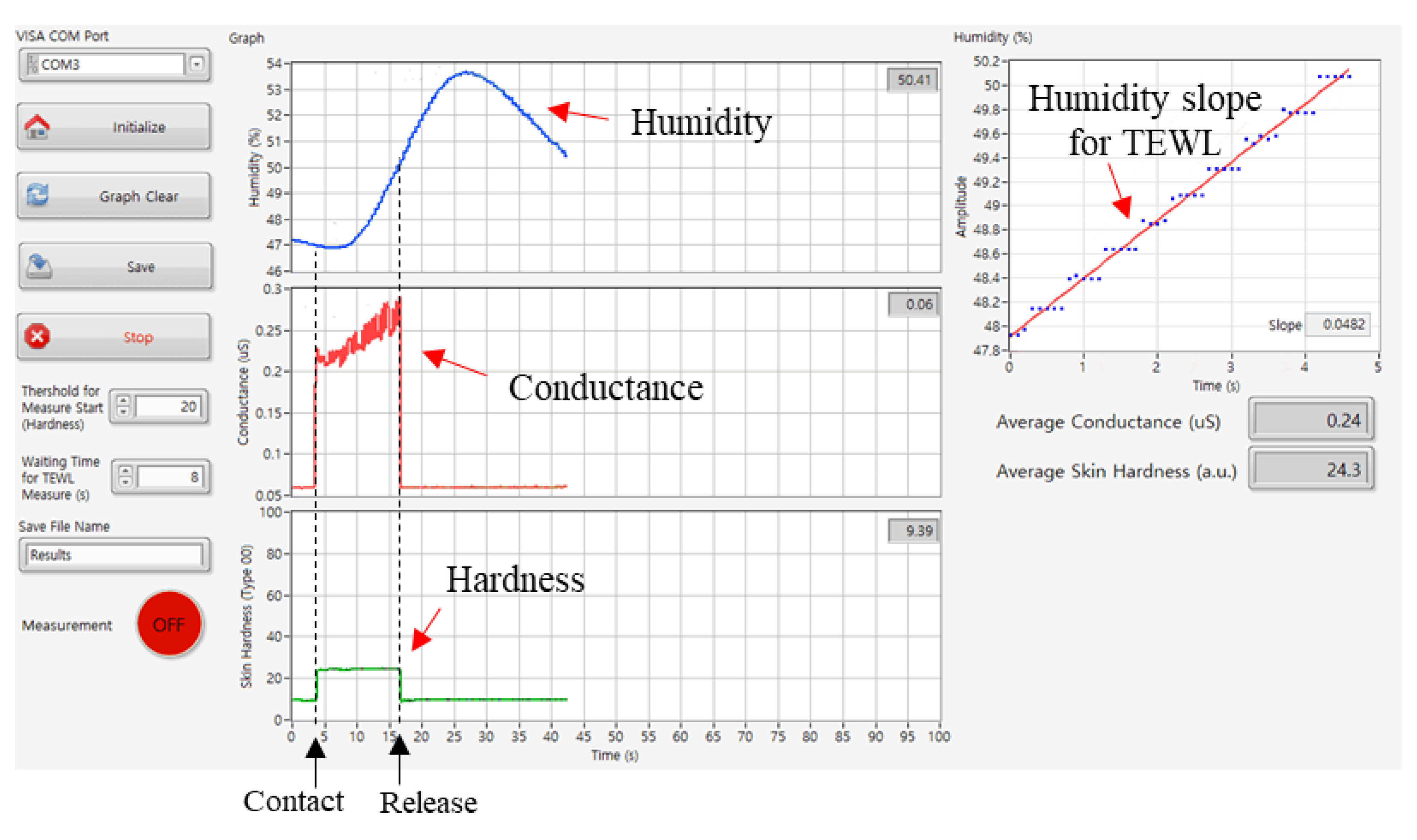
© 2019 by the authors. Licensee MDPI, Basel, Switzerland. This article is an open access article distributed under the terms and conditions of the Creative Commons Attribution (CC BY) license (http://creativecommons.org/licenses/by/4.0/).
Share and Cite
Sim, D.; Kim, S.M.; Kim, S.S.; Doh, I. Portable Skin Analyzers with Simultaneous Measurements of Transepidermal Water Loss, Skin Conductance and Skin Hardness. Sensors 2019, 19, 3857. https://doi.org/10.3390/s19183857
Sim D, Kim SM, Kim SS, Doh I. Portable Skin Analyzers with Simultaneous Measurements of Transepidermal Water Loss, Skin Conductance and Skin Hardness. Sensors. 2019; 19(18):3857. https://doi.org/10.3390/s19183857
Chicago/Turabian StyleSim, Daniel (Jai Kyoung), Sung Mok Kim, Steve S. Kim, and Il Doh. 2019. "Portable Skin Analyzers with Simultaneous Measurements of Transepidermal Water Loss, Skin Conductance and Skin Hardness" Sensors 19, no. 18: 3857. https://doi.org/10.3390/s19183857
APA StyleSim, D., Kim, S. M., Kim, S. S., & Doh, I. (2019). Portable Skin Analyzers with Simultaneous Measurements of Transepidermal Water Loss, Skin Conductance and Skin Hardness. Sensors, 19(18), 3857. https://doi.org/10.3390/s19183857




